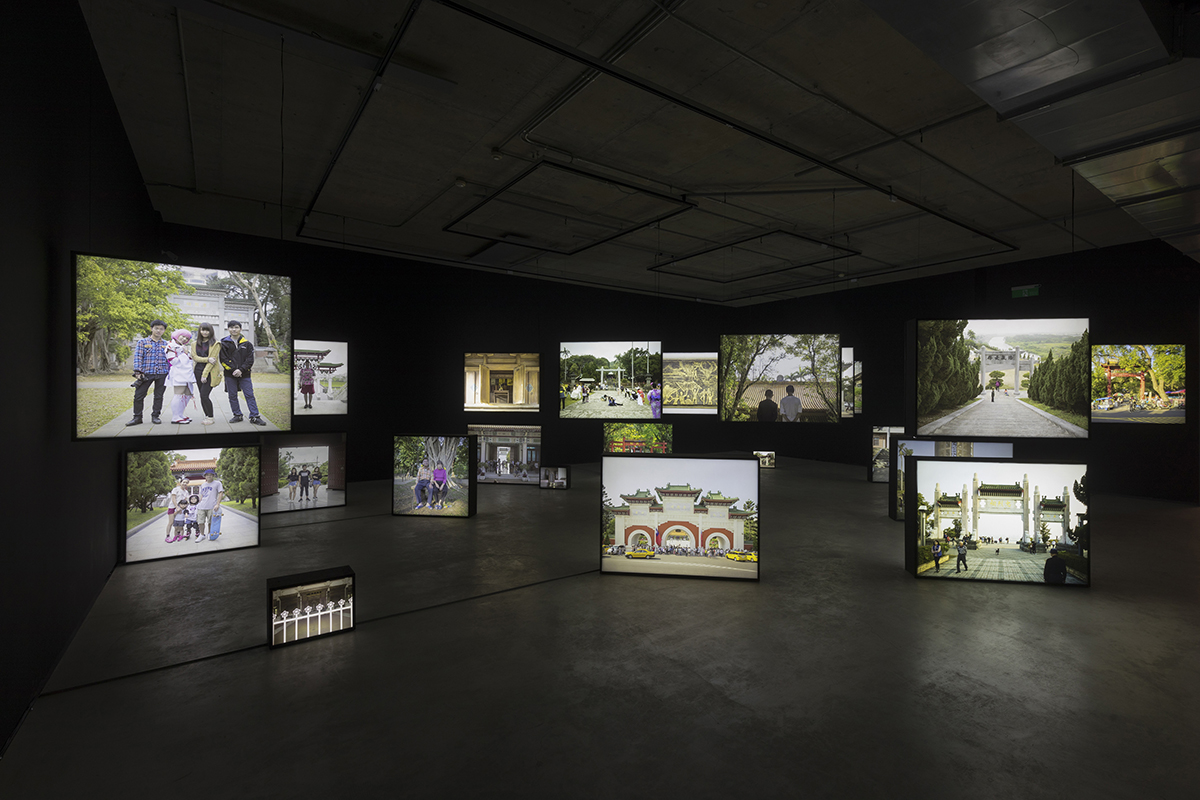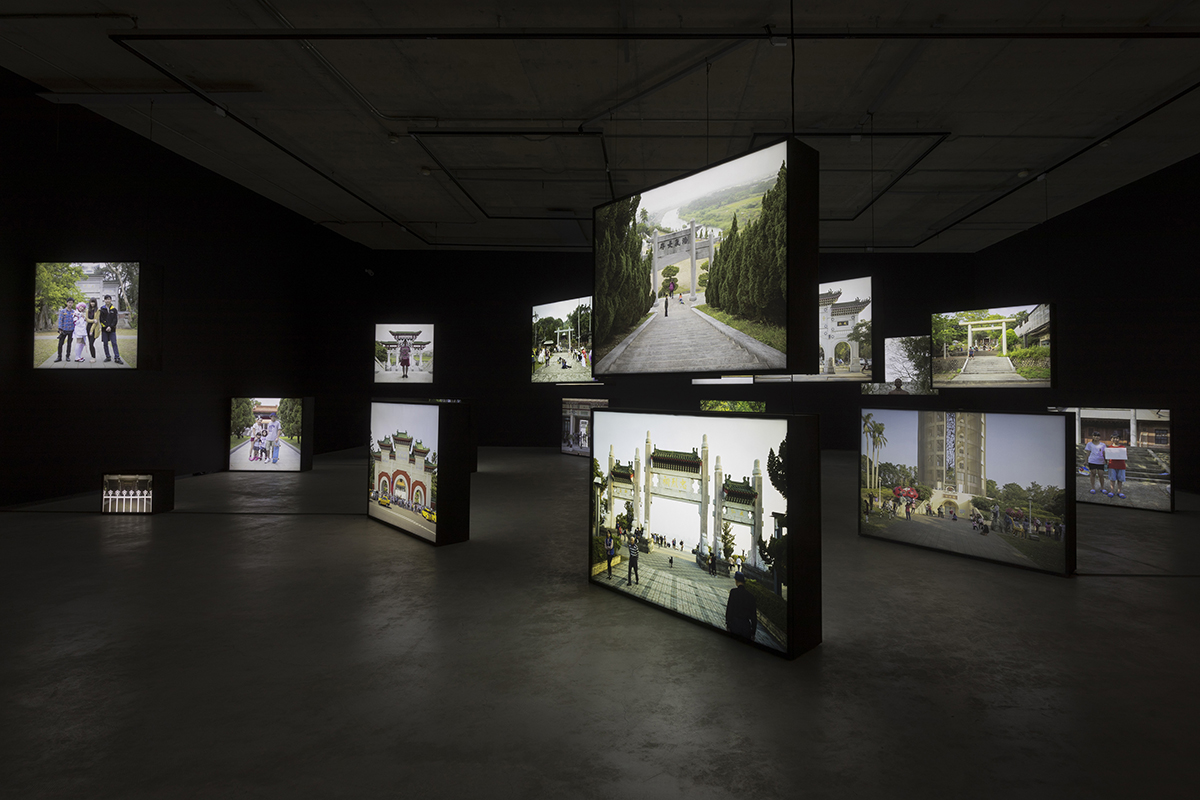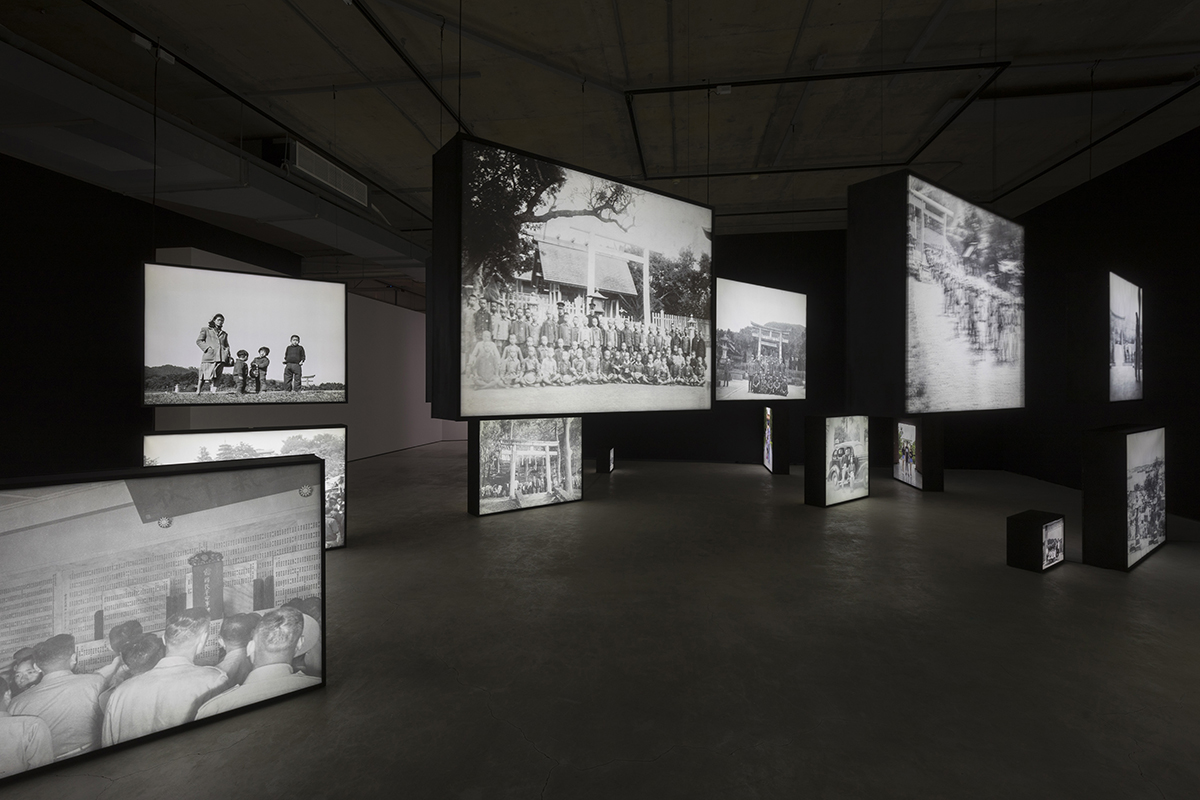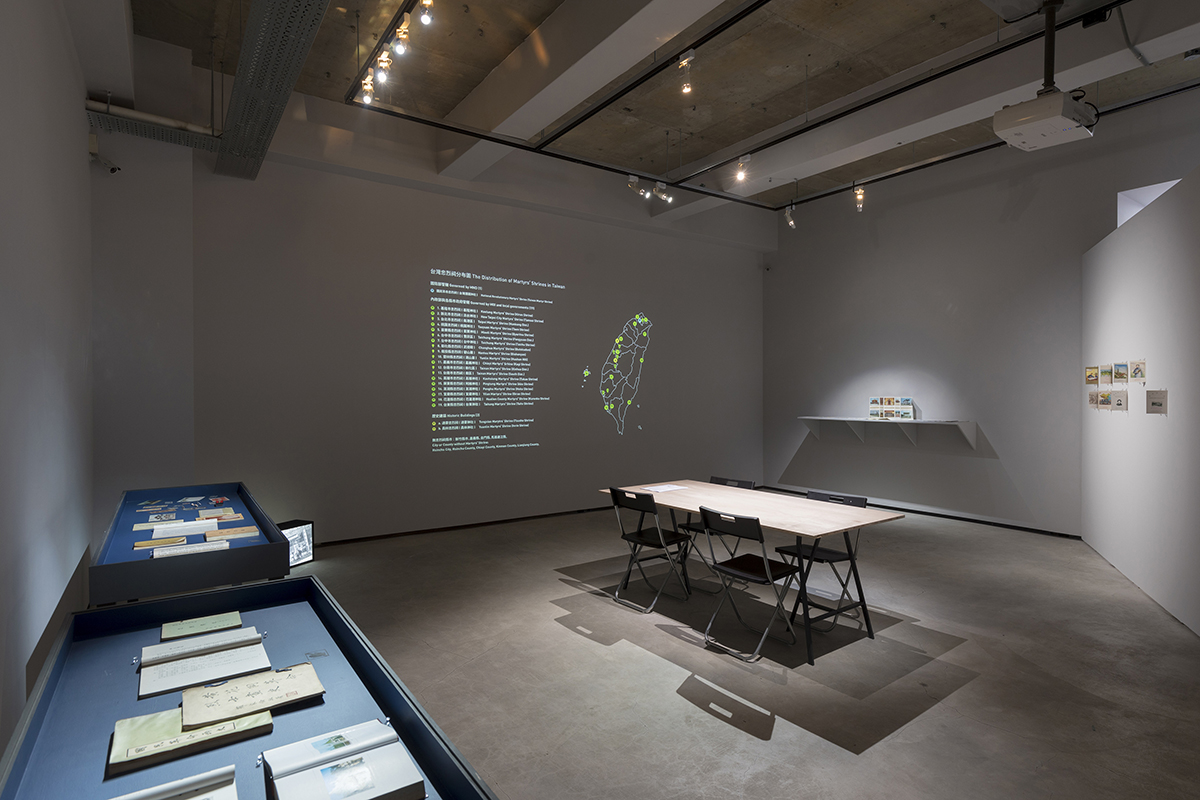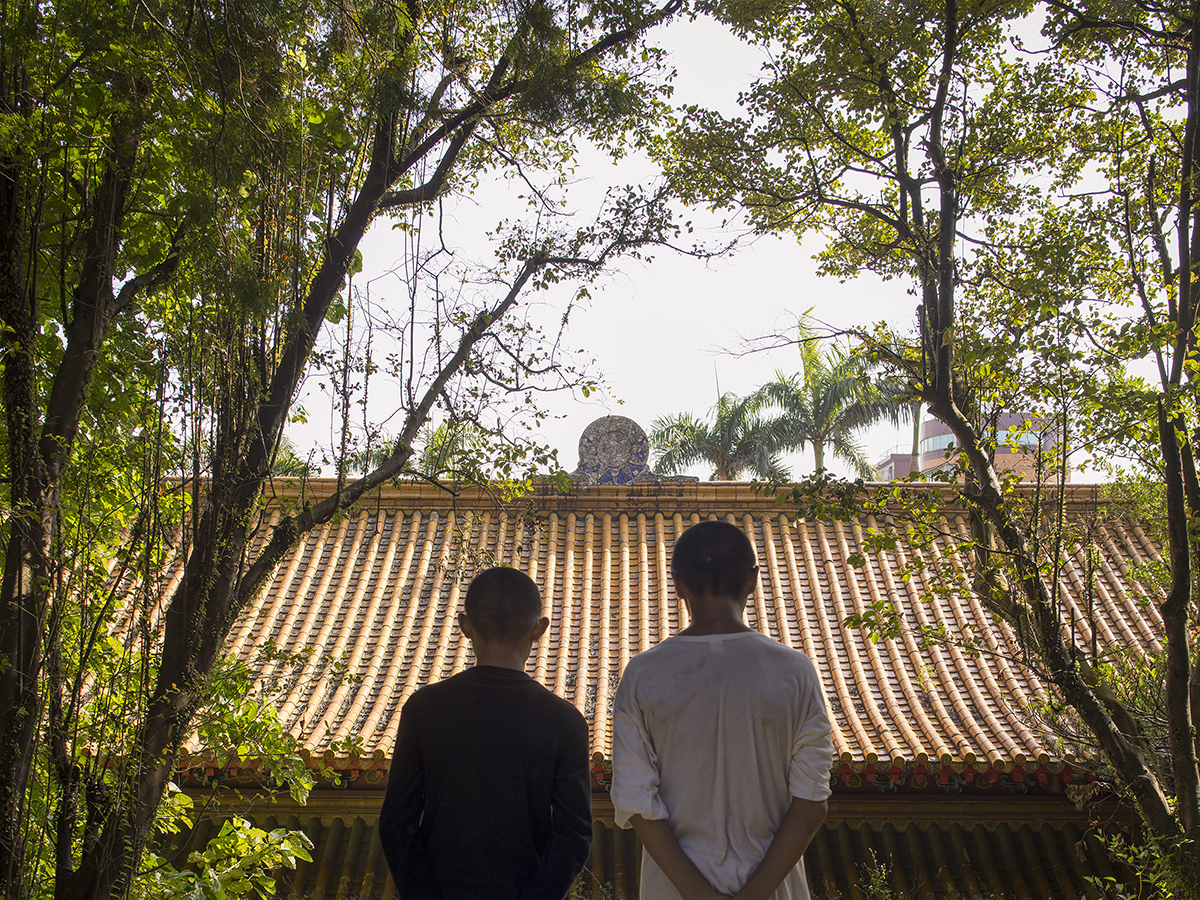
台灣作為被治理的地方,歷經了三百多年外來政權的統治,所有的統治者皆曾藉各種戰爭或外交手段取得這塊土地上的治權,以達到經濟、文化政治或甚至民族上的占有和掠取,台灣在歷史上往往也存在著海洋彼端的殖民母國。這樣的歷史脈絡造就台灣混雜而多元的文化與族群景觀,然而儘管在90年代解嚴後解放了自由思想,至今卻仍無法回應台灣該如何以一個地方之外的意識狀態獨立存在,若台灣可被視為一個共同體,我們應該具備什麼樣的想像,方能取回詮釋的主體性?而若當代藝術能以另類姿態進行社會雕塑,它應以何種方式趨近議題現實?
本次個展是曹良賓近年針對台灣各地的忠烈祠採集、拍攝的影像蒐集計劃,透過影像光體的形式並置神社/忠烈祠的影像與文獻,藉此提供一個在歷史脈絡上的思考:目前存在於台灣的忠烈祠遺跡,都是沿用日本神社建築群改建、或就地重建,而此二曾經衝突的政治實體在神社/忠烈祠之間的繼承關係,見證台灣百年來因被殖民歷史而分斷的認同狀態。當促進轉型正義的議題開始運轉時,我們應該思考如何擺脫傳統文化治理的窠臼,客觀審視忠烈祠的存廢與轉型,在保留其對歷史脈絡、社會事件的紀念與教育責任外,也應積極去除威權時期用作煽動國族情緒的工具性。
展覽的中英文標題個別代表了在議題上不同的切入角度,中文的「想像之所」(imaginarium),直截地回應這次個展希望提問的台灣主體想像與認同議題,「想像」二字源於《想像的共同體》一書,對於民族主義的定義並非如其它方法學那般能夠被清楚論述,而是出於一種族群集體的共識,並逕自區分可供辨識的認同對象。以此,藉「想像之所」命名神社/忠烈祠,不只見證國家權力曾以文化治理的手段框架人民想像的歷史,也因神聖空間的遺址承載的文化景觀,提供了多元開放的想像養份。而英文標題「Becoming/Taiwanese」則是曹良賓對這系列計劃所下的標題,Becoming與Taiwanese兩個獨立並置的字,是他對於「何謂台灣人」的思考,反映了台灣三百多年來不斷置換主權的歷史,是一種對於台灣與台灣人的定義、想像不斷變遷與流動的狀態。在「何謂台灣人」的命題下,反思自身與多數人曾經歷的黨國教育,在解嚴後受客觀歷史啟蒙所遭遇的頓挫與恥辱,他該如何重新與歷史互動?而那些遺緒至今仍無時無刻地在我們的潛意識中運作,影響著我們「台灣人」形塑自我,以及我們與他者的區辨關係。(文/魏榮達)
曹良賓:想像之所
Liang-Pin Tsao: Become / Taiwanese
展期 Dates:2018.03.03 – 2018.04.29
地點 Venue:TKG+ Projects
曹良賓,台灣新竹出生,現居新店,從事影像創作。美國紐約普拉特藝術學院,藝術創作碩士。曾獲選文化部紐約駐村創作計畫、普拉特藝術學院獎學金、美國紐約甘柏馨藝術獎等。作品於國際間展出,創作方向主要關注人與環境之間的互動與張力關係,追索其中的社會和文化意涵。創作之外,亦致力於藝文推廣。曾受邀至台北美術館、台北當代藝術館、台北國際藝術村等機構進行策展、導覽、工作坊等活動。2015年,出版⾸本攝影集《中途》,並與友人共同發起「PHOTO TALKS」,促進台灣當代攝影的討論。2016年,成立「Lightbox 攝影圖書室」,致力於匯集整理台灣的攝影出版物,並提供大眾自由閱讀,獲文化部與國藝會支持贊助。期望以社會參與的⽅式,共構和共享台灣攝影,逐步邁向文化自主、知識自由的正向循環。
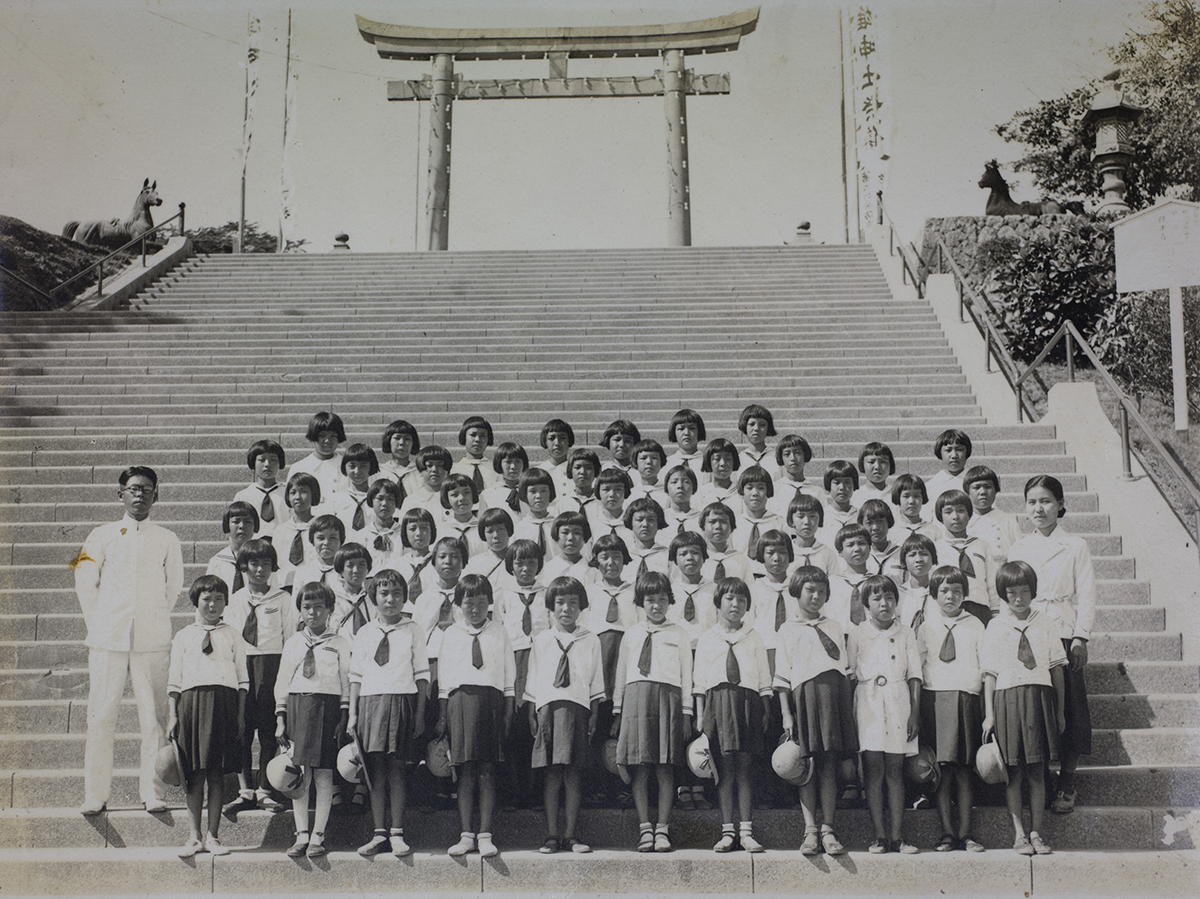
Over 300 years Taiwan had been ruled by foreign regimes which cunningly through warfare and diplomacy acquired the right to rule the island, where the act of public pillage, economic rapine, cultural ravishment, even ethnic plundering, was undertaken. And this contributes largely to the lingering Taiwanese sentiment of an oversea colonial motherland. History has cultivated Taiwan’s cultural and ethnic landscape. Despite the lift of martial law in 1987 and the right to freedom of thought that ensued, Taiwan’s sovereignty remains a haunting question.
Liang-Pin Tsao: Becoming/Taiwanese pivots around Martyrs’ Shrines across the island. Capturing the Martyrs’ Shrines through photography, the artist then transfers the imagery along with archival images of the Shinto shrines onto light boxes, juxtaposed with historical documents, in an attempt to foreground the past relationship between Taiwan and Japan. The existing Martyrs’ Shrines in Taiwan, revamped from Shinto shrines of the Japanese rule period, embody the once conflicted relationship between China and Japan, and bear witness to Taiwan’s fragmented perception of identity, tormented by its colonial past over a hundred years ago. Pondering the issue of transitional justice, the artist prompts the viewer to think about how to break free from the traditional authoritarian shackles, and about the abolishment, the preservation, or the transformation of the Martyrs’ Shrine, in an attempt to not only commemorate these martyrs’ sacrifice and educate the public about the historic lesson, but also rid the shrine of its function as the authoritarian means to instigate nationalist sentiment.
The Chinese exhibition title Xiang Xiang Zhi Suo, a direct translation of “imaginarium,” responds to the artist’s investigation of an imagined Taiwan’s subjectivity and identity. Inspired by the book Imagined Communities: Reflections on the Origin and Spread of Nationalism (1983) by the late American historian Benedict Anderson, the artist names the Shinto/Martyrs’ shrine “imaginarium” with an understanding that nationalism is never easy to define, that it is a collective consensus, that it belongs to distinguishable groups of people. He sees the Shinto/Martyrs’ shrine as a testament to the state’s manipulation of people’s imagined history through cultural dominance, as well as a sacred space that cradles cultural heritage and nurtures vigorous imagination.
“Becoming/Taiwanese,” the English title of the exhibition, is also the name of the photography project. By juxtaposing “Becoming” and “Taiwanese,” the artist contemplates the fluid definition of “Taiwanese” in his examination of the island’s colonized history for the past 300 years. The artist reflects on the education he and so many others have received under the one-party state, as well as their frustration and shame upon learning a different perspective on history after the lift of martial law. The vestiges of the past loiter in the collective subconsciousness, furtively shaping Taiwanese identity and the relationship between “us” and “others.” (Text / Rongda Wei)
About Liang-Pin Tsao
Born and raised in Taiwan, Liang-Pin Tsao is an artist based in Taipei, Taiwan. He holds an MFA degree from Pratt Institute, and his works have been exhibited internationally. Liang is the recipient of New York Residency Program sponsored by the Ministry of Culture Taiwan, Pak-Hing Kan Arts Grant, and scholarship from Pratt Institute among others. His recent works investigate the relational tension between national history, individual identity and value awareness, exploring its socio-cultural significance.
Liang also devotes himself to educational and curatorial affairs, and has conducted many lectures, workshops and curations at Taipei Fine Art Museum, Museum of Contemporary Art Taipei, Taipei Artist Village, etc. He has initiated a symposium project, PHOTO TALKS, since 2015 to help promote contemporary photography in Taiwan. In 2016, he establishes Lightbox Photo Library, a non-for-profit organization supported by National Culture and Arts Foundation and Ministry of Culture, which is free and open to all, and employed as a method to cultural autonomy and freedom of knowledge.
